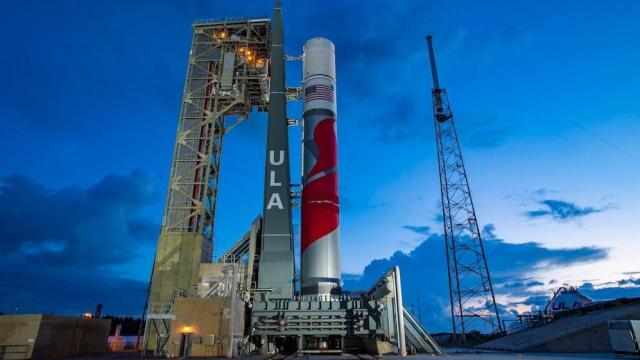After recovering from an explosion at the launch facility last month, United Launch Alliance (ULA) is getting ready to fire up its heavy-lift rocket for a flight readiness test before it can fly for the first time.
ULA’s Vulcan Centaur rocket is scheduled for its static fire test on Thursday, May 25 at 6:00 p.m. ET to make sure all systems are go for launch. The test firing will take place at Space Launch Complex-41 at Cape Canaveral Space Force Station, Florida, and will be broadcast live through ULA’s YouTube channel. You can also tune in to the live action through the feed below.
For the flight readiness test, the rocket won’t actually get off the ground. Instead, ULA will load up its Vulcan Centaur rocket with fuel and fire up its twin booster BE-4 engines and go through the launch countdown. The point behind the firing test is to go through launch day timing and procedures. The rocket already had a tanking test on May 12, in which its hardware, software, and ground systems underwent final review.
The highly-anticipated debut of the Vulcan Centaur rocket was initially scheduled for May 4. Shortly before its liftoff, however, a fiery explosion swept over the rocket’s test stand at NASA’s Marshall Space Flight Centre in Alabama. ULA was pressurizing the upper stage of the Vulcan rocket when a spark ignited due to an accumulation of hydrogen fuel, resulting in a massive fireball.
Following the explosion, ULA conducted an investigation of the incident. The rocket returned to its launch pad on Monday ahead of its final testing before liftoff, which has not been scheduled yet.
A beautiful day to roll. #VulcanRocket pic.twitter.com/BsIf77BZqW
— Tory Bruno (@torybruno) May 22, 2023
Vulcan’s debut has been pushed back several times already. Colorado-based ULA had originally hoped to launch its rocket in 2020 and then again in 2022. The rocket’s first stage is powered by two BE-4 engines built by Blue Origin, which were delivered more than four years past the deadline.
The fully expendable 61.57 m-tall (62-metre) rocket is set to replace ULA’s Atlas V and Delta IV rockets, which have been in use for the past two decades. The Vulcan Centaur is designed to lift 27.2 metric tons (27,216 kg) to low Earth orbit and 6.5 metric tons (6,486 kg) to geosynchronous orbit. The BE-4 engines run on a mixture of liquid methane and liquid oxygen.
For its first mission, the rocket will attempt to deliver Astrobotic’s Peregrine lunar lander, which, on behalf of NASA, is designed to deliver 11 payloads to the surface of the Moon. Vulcan Centaur is also carrying the first two Amazon Kuiper internet satellites, which are supposed to be delivered to low Earth orbit.
There’s a lot riding on the success of its inaugural flight. ULA needs to complete two Vulcan flights in order to get certified to launch U.S. military and intelligence satellites for the Space Force. The company is under contract to deliver 35 missions for the U.S. Space Force in the next five years. The Vulcan rocket is also booked to launch more of Amazon’s internet satellites.
Twitter and bookmark Gizmodo’s dedicated Spaceflight page.
